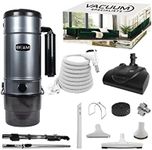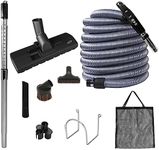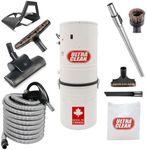Buying Guide for the Best Central Vacuum Systems
Choosing a central vacuum system can make cleaning your home much easier and more efficient. Unlike portable vacuums, central vacuum systems are installed into your home and use a network of pipes to carry dirt and debris to a central collection unit, usually located in a garage or basement. When picking the right system, it's important to consider the size of your home, the types of surfaces you’ll be cleaning, and your personal preferences for convenience and maintenance. Understanding the key specifications will help you find a system that fits your needs and ensures long-term satisfaction.Suction Power (Air Watts)Suction power, often measured in air watts, tells you how effectively the vacuum can pick up dirt and debris. Higher air watts mean stronger suction, which is especially important for deep cleaning carpets or handling larger homes with long pipe runs. For smaller homes or mostly hard floors, a lower air watt rating may be sufficient, while larger homes or those with thick carpets benefit from higher suction power. Consider your home's size and flooring types to decide how much suction you really need.
Filtration SystemThe filtration system determines how well the vacuum traps dust and allergens, which is important for maintaining indoor air quality. There are different types, such as bagged, bagless, and HEPA filters. Bagged systems are easy to maintain and good for allergy sufferers, while bagless systems save on replacement bags but may require more frequent cleaning. HEPA filters are best for those with allergies or asthma, as they capture very fine particles. Think about your household’s sensitivity to dust and how much maintenance you’re willing to do when choosing a filtration type.
Capacity (Dirt Canister Size)Capacity refers to how much dirt and debris the central unit can hold before it needs to be emptied. Larger capacities mean you can go longer between emptying, which is convenient for bigger homes or if you vacuum frequently. Smaller capacities are fine for smaller homes or if you don’t mind emptying the canister more often. Consider your cleaning habits and the size of your home to pick a capacity that matches your needs.
Number of InletsInlets are the wall ports where you connect the vacuum hose. The number and placement of inlets affect how easily you can reach all areas of your home. More inlets mean shorter hoses and easier access, but also more installation work. Fewer inlets may require longer hoses, which can be less convenient. Think about your home’s layout and where you’ll need access to decide how many inlets are right for you.
Noise LevelNoise level is how loud the system is when running. Central vacuum systems are generally quieter than portable vacuums because the motor is located away from living areas, but some units are quieter than others. If you’re sensitive to noise or have young children or pets, look for systems designed for quiet operation. Consider where the central unit will be installed and how much noise you’re comfortable with.
Hose and Attachment OptionsThe hose and attachments determine how versatile and easy to use your system is. Hoses come in different lengths and can be lightweight or heavy-duty. Attachments like power heads, brushes, and crevice tools help you clean different surfaces and hard-to-reach areas. If you have stairs, pets, or a mix of flooring types, look for a system with a variety of attachments. Think about your cleaning needs and choose hose and attachment options that make cleaning easier for you.
Installation RequirementsInstallation requirements refer to how complex it is to set up the system in your home. Some systems are easier to install in new construction, while others can be retrofitted into existing homes. Consider whether you’ll be installing it yourself or hiring a professional, and check if your home’s layout allows for easy installation of pipes and inlets. Your home’s age, size, and construction type will help guide your decision here.
















